Menus
- The Swiss Army Knife sharpened – test in five 2007 vintage days
- Discovery
- In the saddle
- Contact
- City
- Highway
- Departmental
- Comfort
- Braking
- Consumption
- Convenient
- Conclusion
The Swiss Army Knife sharpened – test in five
2007 vintage days
Initially launched in 2000, the FZ1 has massively evolved
in its new vintage. Still from the R1 engine –
2005 to be precise – sporty brand, engine
now benefits from injection with double
butterflies, and complies with the Euro III standard. We can easily spot
this new engine with its matte black color facing the old one
" metal ". A cast aluminum frame replaced
the tubular steel frame. An inverted anodized fork
"Gold" replaced the traditional telescopic fork.
The swing arm gained in curves. The unique saddle was
replaced by a cut-out two-stage saddle.
A compact matte black exhaust replaced the horrible tube
metallic. All these improvements are paid on the bill
final: the FZ1 went from € 9,299 to € 10,990,
or more than 10,000 old francs! Is the price justified ?
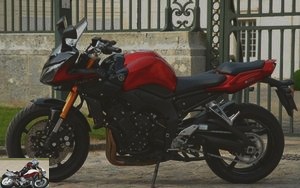
Discovery
You immediately notice the sharp fork crown,
the pot-bellied tank, the anodized front fork, the magnificent
swingarm, barrel exhaust and a huge rear tire
from 190! "Detail", the S also wins a crutch
central, not present on the N model: a detail
increasingly rare, particularly practical in use.
In short, the evolution with the previous model
gave it a lot of youth, especially compared to
to models like the Bandit or the CBF, without going however
as far as a Z 1000. In this game of design, the N version is also
much more successful than the S version.
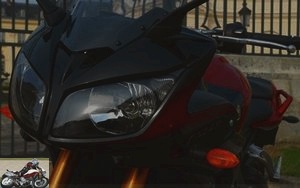
In the saddle
The feet are almost on the ground for the 1.70m pilot,
despite the saddle height of 815mm. Crutch raised
– lateral and central please – the FZ1
seems rather light. The flat bar handlebar falls off
naturally under the hands and the position is natural,
almost straight, even though the handlebars have been lowered
on the new vintage. It is true that it is
of the faired version and the position here is more GT than
roadster, although the footrests were also
readings. The position is therefore more compact than on the old
model but not as much as some competing roadsters.
The meter is then revealed, with a digital speedometer
central and a slightly offset analog tachometer
on the right. Everything is there: partial double trip + reserve trip,
clock, 6-stick fuel gauge, temperature
of water. The red zone appears high at 12,000 rpm. The warnings
are also present.
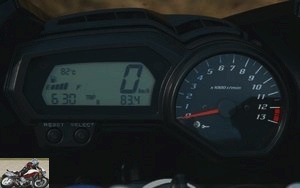
The mirrors appear far ahead on the head of
fork and wide apart. This allows you to see something else
than the arms as on many other motorcycles. And in fact, the mirrors
provide good visibility. Slightly off-center,
they even give the impression of increasing the width
of motorcycle.

Contact
The coded anti-theft transponder key entered, the
counter resets, headlights come on.
The pot distills a discreet sound. At least it is possible to start
in the middle of the night without waking the neighbors.
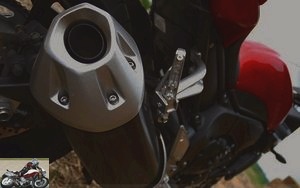
No parasitic vibrations, the bike is ready to go.
City
First … the FZ1 starts on a trickle of gas and stays on it.
It is thus able to wind at 1,500 rpm without complaining.
Even at low speed, the motorcycle appears to be light
and handy, much more than a Z 1000 in particular. Necessarily,
with only 213 kilos, all full facts, she almost cuts a figure
of dancer in front of models who often accuse more
20 kilos more.
Acceleration in the city is gentle
up to 5,000 rpm, then very vigorous afterwards,
even violent if we really open wide.
The first appears here very long, like the second.
Suddenly, the first is taken without batting an eyelid to
120 km / h and without really making the engine scream (not in town),
the second can take it 50 km / h even higher.
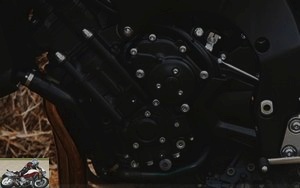
When winding at 2,000 rpm, there is no jerk or hole
acceleration, thanks to a
injection apparently well adjusted. But if we open with a
suddenly, it accelerates really slowly … until
5,000 rpm. And all of a sudden, apart, violently.
Do not hesitate to warn the passenger (I have
almost lost mine on one of those tries).
If the FZ1 is particularly manoeuvrable, the mirrors
eccentricities are a little scary at first; afraid of touching
width between rows. It is then a habit to
take to sneak, which the motorcycle really allows very
easily and effortlessly, even at high speed
scaled down.
The gearbox turns out to be very smooth and the speeds
pass without difficulty. In fact, we quickly forget the box,
especially since the flexibility of the FZ1 does not even encourage
not to shift gears.
On the other hand, the engine heats up well under the pilot and the buttocks benefit
quickly from real heating.

Highway
The FZ1 entered vigorously on the motorway. Protection
of the bubble is then effective without generating
particular eddies on the helmet, whatever the wind, up to
more than 160 km / h. If this protection proves to be good for
a pilot of 1.70, the older ones will greatly appreciate
the assembly of a high screen.
The cruising speed is readily adjusted to this speed
(on German motorway) or more modestly on French motorway
at 125 km / h at 5,000 rpm.
Departmental
The return to departmental roads is easy. Here too,
the FZ1 quickly finds its marks and accepts everything.
For the duo, and to contemplate the landscape, the FZ1 willingly accepts
stall at 80 km / h at 3,000 rpm.
But as much as it is possible to ride quietly, as much she accepts
willingly to roar past 7,000 rpm. Because if accelerates
strong from 5,000 rpm, it is especially above 7,000 rpm
that the FZ1 is unleashed, offering a whole different personality
and this up to 10,000 rpm. The engine then takes its turns willingly,
even violently, especially compared to the expressed gentleness
under 5,000 rpm.
She then takes the pilot along in the manner of a
elastic from one turn to another. The frame is revealed
at this time very rigid, and the bike does not wriggle
At no moment. In addition, she accompanies the pilot at all
moment. A little quick entry into the curve, a light support
on the handlebars, and it literally falls into the bend to
recover excess optimism with a
precision and flawless rigor.
With her, you don’t need to be a pilot, nor to work well
its trajectories. On the contrary, it would tend to make you lazy,
so much she forgives everything and helps the pilot to go everywhere,
very quickly if necessary and with disconcerting ease.
We can not say that the FZ1 is "fun" but it is
damn effective. And by its ability to spend more
quickly than usual everywhere, she values her pilot, pretending
tell him each time: "you see, there too, that
was happening, and you still have room " !
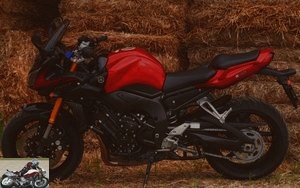
Comfort
The FZ1 offers a long saddle, which turns out to be pleasant
from the start for both pilot and passenger.
This comfort does not change over the miles. He is
therefore possible to go on long journeys without suffering particularly,
even if this vintage has lost in comfort compared to the model
preceding; the fault of a thinner saddle
and suspensions noticeably firmer. But compared to
a Z 1000, it’s still a Pullman.
The passenger has handles and sits relatively well
protected. The saddle, not too high, allows you to
stride easily, and to have relative protection during
the paths.

Braking
The FZ1 benefits from the same brakes as the R1: a
double 320 mm front disc equipped with calipers
4 radial pistons. However, braking remains very gradual.
The rear brake is a real brake playing a real role with
very good efficiency (for a rear brake).
The front brake offers a good feeling and good progressiveness,
failing to have a strong bite. On the other hand, it is
very efficient and unsurprising.
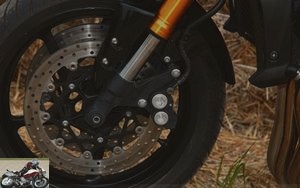
Consumption
The fuel gauge – made up of 6 sticks –
turns out to be very precise. She loses a stick
every 40 kms (even 50 km in cool driving), until the last
stick, signaling the passage in reserve from 190 km,
even 175 km after a fast pace. A partial reserve trip
automatically starts up, increasing the number of
kilometers from the passage in reserve. It remains then
theoretically 3.4 liters (reserve volume) even
if during my test I only put 12.5 liters when filling
to the brim. There is then a range of 60 kilometers,
for an overall autonomy varying between 250 and 300 km. The former owners
of Fazer 1000 will regret the 3 liters lost in favor of the
air. She would really benefit from having at least a liter more
in the tank.
In smooth driving, what the FZ1S encourages, consumption therefore turns
at 6.5 liters per hundred.
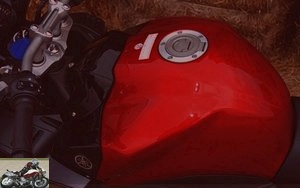
Convenient
The saddle offers some space for a short U and the
tool, but no more. As for the U, it must really be very
short.
The FZ1 S accepts optional suitcases, giving it an almost FJR look.
There is also a high screen, a lower fairing,
heated grips and protective rollers.

Conclusion
The FZ1S is a motorcycle that hides its game well with its GT look, the air of
do not touch it. So, we don’t necessarily turn away
as it passes. But it is totally transformed on contact with the
pilot to become an efficient, precise, lively motorcycle …,
she reveals her origins as a sportswoman with all the qualities
expected in terms of power, frame stiffness, and performance,
more comfort. More pointed, however, than the old model,
it lost some of the GT characteristics that had made the success
of the previous vintage for the benefit of sportiness.
She may disappoint those who appreciated her side
grandpa. On the contrary, it will delight those who want to be able to
ride but also have fun with exemplary behavior and
fabulous ease of handling. Only its price rising to
€ 10,990.00 – notably against the Bandit 1250 at € 7,499
– could constitute a handicap for a well-deserved success.
Strong points
- Ease of handling
- Motor player high in the towers
Weak points
- Autonomy
- Housing under the saddle
Forum test
test
Competitors: Honda CBF 1000, Suzuki
Bandit 1200, Triumph Speed Triple
The 2000 vintage test
Datasheet
/ comparo 2000/2007
Related articles
-
Yamaha Fazer FZ6 S2 motorcycle test
The ultimate evolution of success The Fazer, now called FZ6 S2, celebrates its tenth anniversary. The engine originally from the Thundercat has been…
-
Suzuki SV 1000 S motorcycle test
The sports tractor Presented at Intermot 2002, the SV 1000 is the descendant of the deceased TL 1000S, born itself in 1996: a sporty twin of 1000 cm3…
-
Yamaha TDM 900 GT ABS motorcycle test
The Yamaha TDM 900 GT has everything a big one with an imposing size, even more in its GT version – compared to the basic TDM 900 version – in particular…
-
Suzuki DL 650 VStrom motorcycle test
Small GT with a big heart The DL 650 is the little sister of the DL 1000: a V-shaped twin cylinder with 90 ° of 650 cm3. Born a year after her big sister…
-
Without hesitation 4 cylinders in line, 165 hp, 114 Nm, 199 kg, Flex Frame, LED headlight, 14,980 euros The BMW S 1000 R is the roadster version of the…
-
Honda Varadero 1000 XLV motorcycle test
Maxi-Trail with a road vocation The Honda XL 1000 V Varadero, which appeared in 1998, is the heir to the famous Africa Twin … but the manufacturer has…
-
Zero SR / S electric motorcycle test
Z-Force battery of 14.4 kWh, Torque 190 Nm, 229 kg, € 21,700 Quiet Watts ! It has been a few years since electric motorcycles arrived on the market, Zero…
-
Yamaha Fazer FZ6 motorcycle test
The GT roadster The Fazer has been completely revised for its edition 2004, Euro2 standard obliges. In fact, the new model has nothing to do with its…
-
Triumph Daytona 675 motorcycle test
After several sports trials 4 cylinders in 600 cm3 (TT 600 then Daytona 600), Triumph gives up to reveal finally a sports 600 based on a 3 cylinder: the…
-
Honda CBF 1000 ABS motorcycle test
The Honda CBF 1000 is the big sister of the CBF 600, which appeared in 2006. Apart from a slightly larger size, the two models are aesthetically very…